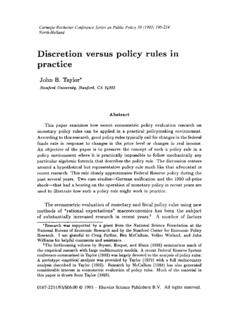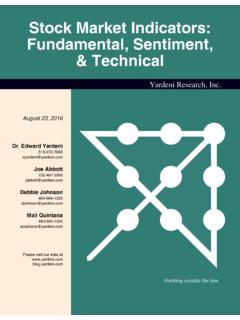Transcription of Central bank cryptocurrencies
1 BIS Quarterly Review, September 2017 55 Central bank cryptocurrencies1 New cryptocurrencies are emerging almost daily, and many interested parties are wondering whether Central banks should issue their own versions. But what might Central bank cryptocurrencies (CBCCs) look like and would they be useful? This feature provides a taxonomy of money that identifies two types of CBCC retail and wholesale and differentiates them from other forms of Central bank money such as cash and reserves. It discusses the different characteristics of CBCCs and compares them with existing payment options. JEL classification: E41, E42, E51, E58. In less than a decade, bitcoin has gone from being an obscure curiosity to a household name. Its value has risen with ups and downs from a few cents per coin to over $4,000.
2 In the meantime, hundreds of other cryptocurrencies equalling bitcoin in market value have emerged (Graph 1, left-hand panel). While it seems unlikely that bitcoin or its sisters will displace sovereign currencies, they have demonstrated the viability of the underlying blockchain or distributed ledger technology (DLT). Venture capitalists and financial institutions are investing heavily in DLT projects that seek to provide new financial services as well as deliver old ones more efficiently. Bloggers, Central bankers and academics are predicting transformative or disruptive implications for payments, banks and the financial system at Lately, Central banks have entered the fray, with several announcing that they are exploring or experimenting with DLT, and the prospect of Central bank crypto- or digital currencies is attracting considerable attention.
3 But making sense of all this is difficult. There is confusion over what these new currencies are, and discussions often occur without a common understanding of what is actually being proposed. This feature seeks to provide some clarity by answering a deceptively simple question: what are Central bank cryptocurrencies (CBCCs)? To that end, we present a taxonomy of money that is based on four key properties: issuer ( Central bank or other); form (electronic or physical); accessibility (universal or limited); and transfer mechanism (centralised or decentralised). The 1 The views expressed in this article are those of the authors and do not necessarily reflect those of the BIS. We thank Claudio Borio, Stijn Claessens, Benjamin Cohen, Dietrich Domanski, Hana Halaburda, Krista Hughes, Jochen Schanz and Hyun Song Shin for comments as well as Aleksander Berentsen, James Chapman and Paul Wong for insightful discussions.
4 We are grateful to Codruta Boar for excellent research assistance. 2 See Andolfatto (2015, 2016), Broadbent (2016), Raskin and Yermack (2016) and Skingsley (2016). Morten 56 BIS Quarterly Review, September 2017 taxonomy defines a CBCC as an electronic form of Central bank money that can be exchanged in a decentralised manner known as peer-to-peer, meaning that transactions occur directly between the payer and the payee without the need for a Central This distinguishes CBCCs from other existing forms of electronic Central bank money, such as reserves, which are exchanged in a centralised fashion across accounts at the Central bank. Moreover, the taxonomy distinguishes between two possible forms of CBCC: a widely available, consumer-facing payment instrument targeted at retail transactions; and a restricted-access, digital settlement token for wholesale payment But what might the two types of CBCC offer that alternative forms of Central bank money cannot?
5 For the consumer-facing kind, we argue that the peer-to-peer element of the new technology has the potential to provide anonymity features that are similar to those of cash but in digital form. If anonymity is not seen as important, then most of the alleged benefits of retail CBCCs can be achieved by giving the public access to accounts at the Central bank, something that has been technically feasible for a long time but which Central banks have mostly stayed away from. On the wholesale side, the assessment of CBCCs is quite different. Wholesale payments today do not offer cash-like anonymity. In particular, transactions that occur in wholesale systems are visible to the Central operator. Hence, the case for wholesale CBCCs depends on their ability to improve efficiency and reduce settlement 3 The purest form of peer-to-peer transaction is a cash exchange.
6 On a computer network, the peer-to-peer concept means that transactions can be processed without the need for a Central server. 4 It is common to divide payments into retail and wholesale segments. Retail payments are relatively low-value transactions, in the form of eg cheques, credit transfers, direct debits and card payments. By contrast, wholesale payments are large-value and high-priority transactions, such as interbank transfers. The distinction might become less relevant in a world with CBCCs. In that case, our usage would reflect the types of payment primarily targeted by CBCCs. Bitcoin Graph 1 Closing price and market capitalisation Bitcoin price volatility1 Average daily transactions3 USD 000s USD bn USD Ratio Mn USD mn 1 Ninety-day moving averages.
7 2 Ratio of standard deviation to mean. 3 Monthly averages. For bitcoin, estimated transaction value in USD; for M-pesa , transaction value in KES converted into USD. Sources: Central Bank of Kenya; CoinDance; CoinDesk; ; authors calculations. 17Q1 17Q3 16Q1 16(lhs)priceBitcoinBitcoinOther digital currenciesCapitalisation (rhs) deviation (lhs)Coefficient of variation (rhs)21086420750600450300150017151311090 7 Number (lhs):Value (rhs): Bitcoin M-pesa BIS Quarterly Review, September 2017 57 costs. Here, the answer depends on a number of technical issues that still need to be resolved. Some Central banks have experimented with wholesale CBCCs, but none has announced yet that it is ready to adopt this technology. The first section presents the taxonomy underlying our definition. The following two sections discuss the features of the two basic CBCC types, retail and wholesale, drawing on historical examples and projects that are currently under way.
8 A concluding section reflects on some of the issues that Central banks need to consider in this area going forward. A new form of Central bank money Our starting point for defining CBCCs is a report on cryptocurrencies published in 2015 by the Committee on Payments and Market Infrastructures (CPMI (2015)).5 This report sought to provide a definition of the new class of currencies represented by bitcoin and altcoins (alternatives to bitcoin) that had emerged using the same technology. The report identifies three key characteristics of cryptocurrencies : they are electronic; are not the liability of anyone; and feature peer-to-peer cryptocurrencies utilise DLT (Box A) to allow remote peer-to-peer transfer of electronic value in the absence of trust between contracting parties. Usually, electronic representations of money, such as bank deposits, are exchanged via centralised infrastructures, where a trusted intermediary clears and settles transactions.
9 Previously, peer-to-peer exchange was restricted to physical forms of money. Some but not all of these features are also common to other forms of money (Graph 2, left-hand panel). Cash is peer-to-peer, but it is not electronic, and it is a Central bank liability. Commercial bank deposits are a liability of the bank that issues them. Nowadays, they are in electronic form and are exchanged in a centralised manner either across the books of a given bank or between different banks via the Central bank. Most commodity monies, such as gold coins, may also be transferred in a peer-to-peer fashion but are neither the liability of anyone nor It may seem natural to define CBCCs by adapting the CPMI s definition to say that they are electronic Central bank liabilities that can be used in peer-to-peer exchanges.
10 But this ignores an important feature of other forms of Central bank money, namely accessibility. Currently, one form of Central bank money cash is of course accessible to everyone, while Central bank settlement accounts are typically available only to a limited set of entities, mainly banks (CPSS (2003, p 3)). In this spirit, Bjerg (2017) includes universally accessible (ie easy to obtain and use) in addition to electronic and Central bank-issued in defining the new concept of Central bank digital currency (Graph 2, right-hand panel). 5 The report s title is Digital currencies, but it notes that such schemes are frequently also referred to as cryptocurrencies , reflecting the use of cryptography in their issuance and their validation of transactions. 6 cryptocurrencies have no intrinsic value and are only held in the belief that they might be exchanged for goods or services at a later point in time.












